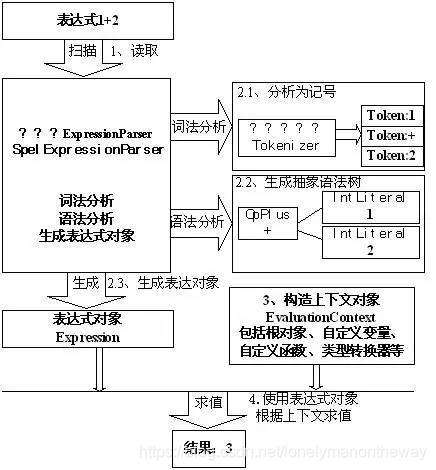Spring,Spring Expression Language,SpEL,类似于Struts2x中使用的OGNL表达式语言(以及jsp的EL)),能在运行时构建复杂表达式、存取对象图属性、对象方法调用等。表达式语言给静态Java语言增加动态功能。SpEL是单独模块,只依赖于core模块,可以单独使用,依赖如下,但是一般无需独立引入,作为spring核心组件,常被其他组件作为基础依赖,实现若干功能:如配合配置Bean定义。
<dependency>
<groupId>org.springframework</groupId>
<artifactId>spring-expression</artifactId>
<version>5.2.5.RELEASE</version>
</dependency>
SpEL支持如下表达式:
- 基本表达式:字面量表达式、关系,逻辑与算数运算表达式、字符串连接及截取表达式、三目运算及Elivis表达式、正则表达式、括号优先级表达式;
- 类相关表达式:类类型表达式、类实例化、instanceof表达式、变量定义及引用、赋值表达式、自定义函数、对象属性存取及安全导航表达式、对象方法调用、Bean引用;
- 集合相关表达式:内联List、内联数组、集合,字典访问、列表,字典,数组修改、集合投影、集合选择;不支持多维内联数组初始化;不支持内联字典定义;
- 其他表达式:模板表达式。
注:SpEL表达式中的关键字是不区分大小写的。
通过实例分析SpEL求表达式值的步骤:
public class SpELTest {
@Test
public void helloWorld() {
// 1.创建解析器, 提供SpelExpressionParser默认实现
ExpressionParser parser = new SpelExpressionParser();
// 2.解析表达式, parseExpression方法解析得到Expression对象
Expression expression = parser.parseExpression("('Hello' + ' World').concat(#end)");
// 3.构造上下文, 设置数据
EvaluationContext context = new StandardEvaluationContext();
context.setVariable("end", "!");
// 4.Expression接口的getValue方法
Assert.assertEquals("Hello World!", expression.getValue(context));
}
}
SpEL原理及接口
- 表达式:表达式是表达式语言的核心,所以表达式语言都是围绕表达式进行的,“干什么”;
- 解析器:用于将字符串表达式解析为表达式对象,“谁来干”;
- 上下文:表达式对象执行的环境,该环境可能定义变量、定义自定义函数、提供类型转换等等,“在哪干”;
- 根对象及活动上下文对象:根对象是默认的活动上下文对象,活动上下文对象表示了当前表达式操作的对象,“对谁干”。

核心流程:
SpelExpressionParser解析器内部使用Tokenizer类进行词法分析,即把字符串流分析为记号流,记号在SpEL使用Token类来表示;
得到记号流后,解析器便可根据记号流生成内部抽象语法树;
在SpEL中语法树节点由SpelNode接口实现代表:如OpPlus表示加操作节点、IntLiteral表示int型字面量节点;
使用SpelNodel实现组成抽象语法树;
对外提供Expression接口来简化表示抽象语法树,从而隐藏内部实现细节,并提供getValue简单方法用于获取表达式值;
SpEL提供默认实现为SpelExpression;
定义表达式上下文对象(可选),SpEL使用EvaluationContext接口表示上下文对象,用于设置根对象、自定义变量、自定义函数、类型转换器等,SpEL提供默认实现StandardEvaluationContext;
public interface ExpressionParser {
Expression parseExpression(String expressionString);
Expression parseExpression(String expressionString, ParserContext context);
}
EvaluationContext接口:
public interface EvaluationContext {
/**
* Return the default root context object against which unqualified
* properties/methods/etc should be resolved. This can be overridden
* when evaluating an expression.
*/
TypedValue getRootObject();
/**
* Return a list of accessors that will be asked in turn to read/write a property.
*/
List<PropertyAccessor> getPropertyAccessors();
/**
* Return a list of resolvers that will be asked in turn to locate a constructor.
*/
List<ConstructorResolver> getConstructorResolvers();
List<MethodResolver> getMethodResolvers();
@Nullable
BeanResolver getBeanResolver();
/**
* Return a type locator that can be used to find types, either by short or
* fully qualified name.
*/
TypeLocator getTypeLocator();
/**
* Return a type converter that can convert (or coerce) a value from one type to another.
*/
TypeConverter getTypeConverter();
/**
* Return a type comparator for comparing pairs of objects for equality.
*/
TypeComparator getTypeComparator();
/**
* Return an operator overloader that may support mathematical operations
* between more than the standard set of types.
*/
OperatorOverloader getOperatorOverloader();
void setVariable(String name, @Nullable Object value);
/**
* Look up a named variable within this evaluation context.
* @param name variable to lookup
* @return the value of the variable, or {@code null} if not found
*/
@Nullable
Object lookupVariable(String name);
}
默认实现是StandardEvaluationContext类,使用setRootObject方法来设置根对象,使用setVariable方法来注册自定义变量,使用registerFunction来注册自定义函数等。
SpringExpressions.g文件,.g后缀名文件,采用Glagol DSL语法写的配置文件。
@Value可以配合SpEL表达式一起使用,读取properties文件内容:
@Value("#{configProperties['ora_driver']}")
